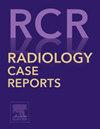以急性肠系膜出血为表现的正中弓状韧带综合征1例
Q4 Medicine
引用次数: 0
摘要
中弓韧带综合征(MALS)是一种相对常见但未被充分认识的疾病,由中弓韧带外部压迫腹腔动脉引起。虽然通常无症状,肌萎缩侧索硬化症可表现为慢性胃肠道症状,很少有急性并发症,由于侧支血管破裂。我们提出的情况下,59岁的妇女谁到达农村急诊科急性左侧疼痛和呕吐,最终诊断为腹内出血从破裂的假性动脉瘤。在慢性腹腔动脉狭窄中,侧枝通路,特别是b本文章由计算机程序翻译,如有差异,请以英文原文为准。
Median arcuate ligament syndrome presenting as acute mesenteric hemorrhage: A case report
Median arcuate ligament syndrome (MALS) is a relatively common, yet under-recognized condition caused by external compression of the celiac artery by the median arcuate ligament. Although often asymptomatic, MALS may present with chronic gastrointestinal symptoms, and rarely, with acute complications due to collateral vessel rupture.
We present the case of a 59-year-old woman who arrived at a rural emergency department with acute left flank pain and emesis, ultimately diagnosed with intra-abdominal hemorrhage from a ruptured pseudoaneurysm. In chronic celiac artery stenosis, collateral pathways, particularly the Arc of Bühler and the pancreaticoduodenal arcade can become hypertrophied and predisposed to pseudoaneurysm formation. Rupture of these pseudoaneurysms may mimic other causes of acute mesenteric bleeding, such as hemorrhagic pancreatitis, and carry high mortality if not promptly identified.
This case underscores the importance of recognizing splanchnic arterial collaterals as potential sources of hemorrhage in MALS and highlights the need for early imaging, especially in resource-limited settings. Prompt angiographic assessment and embolization can be lifesaving.
求助全文
通过发布文献求助,成功后即可免费获取论文全文。
去求助
来源期刊

Radiology Case Reports
Medicine-Radiology, Nuclear Medicine and Imaging
CiteScore
1.10
自引率
0.00%
发文量
1074
审稿时长
30 days
期刊介绍:
The content of this journal is exclusively case reports that feature diagnostic imaging. Categories in which case reports can be placed include the musculoskeletal system, spine, central nervous system, head and neck, cardiovascular, chest, gastrointestinal, genitourinary, multisystem, pediatric, emergency, women''s imaging, oncologic, normal variants, medical devices, foreign bodies, interventional radiology, nuclear medicine, molecular imaging, ultrasonography, imaging artifacts, forensic, anthropological, and medical-legal. Articles must be well-documented and include a review of the appropriate literature.
 求助内容:
求助内容: 应助结果提醒方式:
应助结果提醒方式:


